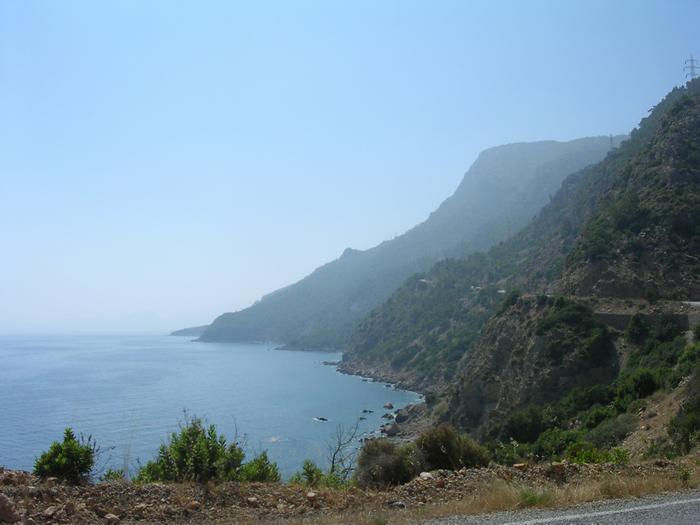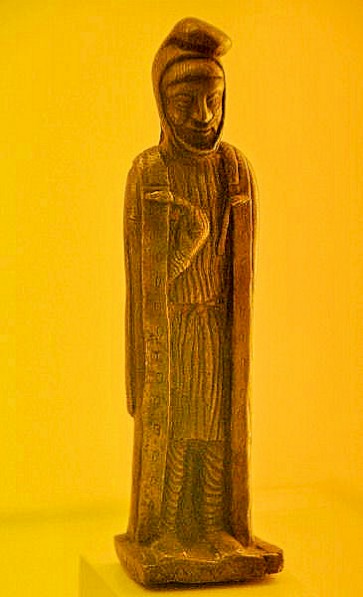Cilicia
Q620864Cilicia: ancient name of what is now southern Turkey. The Persian king Cyrus the Great conquered this country, and after the fall of the Achaemenid empire, Cilicia belonged to the Seleucid and Roman Empires. It was well-known for its iron and silver ores.
Topography

Cilicia as a whole consists of two parts: the inaccessible western area of the Taurus mountains, also known as "rough Cilicia", and the eastern plains, which are dominated by the rivers Cydnus, Sarus and Pyramis and are rich in cereals. The Taurus is the region's northern border. Here, we find the Cilician Gate, a pass that connects the plain with Cappadocia in the north. To the south, the Mediterranean sea is Cilicia's neighbor, and the region had (and has) close contacts with Cyprus. In the east the Syrian gates are the connection with Syria and Mesopotamia.
Bronze Age
From times immemorial, the two areas belong together. In the second half of the the second millennium BCE, the entire region, known as Kizzuwatna, was part of the Hittite Empire. Contemporary sources mention the two main cities on the plains: the residence known as Tarša (Tarsus) and Adanija (Adana). The most important language was Luwian. In those days, the region was ruled by a prince from the Hittite royal family, who was called "priest".
Iron Age

After the fall of the Hittite Empire (after 1190 BCE), the two areas were included in a new, "Neo-Hittite" kingdom called Tarhuntassa, which had its capital somewhere in Pamphylia. It is not known how long this state existed. When the Assyrians discovered the region in the ninth century, they called the fertile eastern area Qu'e (with important towns in Karatepe and Adana), and the western area Hilakku; from this word our Cilicia is derived.
The plains of Qu'e (also known as Awariku) were first conquered by the Assyrians. King Tiglath-pileser III (744-727) appointed a governor, whose residence was Adana. However, it was not a secure possession of the Assyrian empire: after the death of Sargon II in 705, it became independent again under the old dynasty, the house of Muksa. The ancestor of the Qu'ean royal family is known from Phoenician sources as Mpš, and can (according to an inscription from Karatepe) be identified with the Mopsus from Greek legend, who is said to have founded a town and an oracle in Cilicia. The Assyrian king Esarhaddon (680-669) reconquered the area.

Meanwhile, Hilakku remained independent. The Assyrians were not interested in the underdeveloped mountain area and its poor tribes. However, during the reign of Aššurbanipal (668-631 BCE), Hilakku was threatened by the Cimmerians, a nomadic tribe from the northeast that had already overrun Armenia. Therefore, Hilakku placed itself under Assyrian protection.
In 612, the Babylonians and Medes captured the Assyrian capital Nineveh (more). Hilakku survived the collapse of Assyria. A new kingdom came into being, in which both areas were united. Its capital was Tarsus. The Greeks rendered the title of its kings, suuannassai, as syennesis, and the name of the country as Cilicia.

The first syennesis we know about, is mentioned by the Greek researcher Herodotus of Halicarnassus (fifth century BCE). He tells that in 585, the syennesis and one Labynetus of Babylon (probably the future king Nabonidus) negotiated a peace treaty between king Alyattes of Lydia and Cyaxares, the leader of the Medes. The story confirms that Cilicia was at this time an independent power and did not belong to the Babylonian empire of king Nebuchadnezzar.
This syennesis was succeeded by one Appuašu, who withstood an invasion of the Babylonian army under king Neriglissar in 557/556 (ABC 6). It had been argued that Cilicia was invaded because it had become a protectorate of the Median empire, or may have appeared to have become a Median subject. We cannot know.
Persian period

It is certain that in 547/546, the Persian king Cyrus the Great campaigned in the countries west or north of the Tigris. Unfortunately, our source (the Chronicle of Nabonidus) contains a lacuna. It is not impossible (but unlikely) that Lydia is meant, where king Croesus was defeated. However this may be, at some time in the 540s, Cyrus added Cilicia to the Achaemenid empire, making the syennesis (perhaps Appuwašu) a vassal king. Babylonian sources do not mention imported Cilician iron after 545, which strongly suggests that there were no trade contacts any more.
After the reign of a man named Oromedon, who is just a name, the next syennesis is better known. The Persian king Xerxes chose Cilicia to gather a large army to attack the Greek homeland (481 BCE). Next year, the syennesis served as one of the commanders in the Persian navy. He is known to have married his daughter to Pixodarus, a Carian leader.
At this stage, we begin to know a bit more about the way the Persians governed and used Cilicia. Its capital was Tarsus, where the loyal syennesis had its residence. We may assume that there was a Persian garrison. At several other places, we find military bases, mostly along the sea coast. The coastal plain often served to assemble armies. Although Cilicia had a native king, it had to pay tribute: 360 horses and 500 talents of silver, according to Herodotus.
During the Persian era, the fertile Cilician plains were the most important part of the satrapy. The relations between the inhabitants of the cities and those of the villages in the eastern mountains were sometimes less than friendly. After all, the people from the plains were sedentary agriculturalists and the mountain people were roaming herdsmen. It is certain that in the fourth century, the two groups sometimes came to blows, and we may assume that this was also true in the fifth century.
There were several important sanctuaries that remained more or less independent from Persian rule. One of the most important was that of a mother goddess that was called Artemis Perasia by the Greeks and Cybele by everybody else. Her shrine was at Castabala in the northeast. During the reign of king Artaxerxes II Mnemon, the Castabalans briefly revolted, but they were subdued by general Datames.

Another sanctuary was Mazaca, which must have been more to the Persians' taste. Here, the sacred fire was worshipped. Another site of religious importance was the oracle at Mallus.
At the end of the fifth century, the third known and probably last syennesis was ruling Cilicia. He became involved in a civil war between Artaxerxes II and his brother Cyrus the Younger. When the latter approached the Cilician gate, the syennesis was forced to side with him. However, after the defeat of Cyrus at Cunaxa near Babylon, the syennesis' position was difficult and he was dethroned. This marked the end of the independence of Cilicia. After 400, it became an ordinary satrapy.
One of its satraps was the Babylonian Mazaeus (361-336). His successor was expelled by the Macedonian king Alexander the Great, who conquered Cilicia in the summer of 333, and fell ill at Tarsus (text). After some time, he recovered and attacked the Cilicians of the Taurus mountains. This was probably a police action against the herdsmen. The new satrap of Cilicia, a man named Balacrus, was given special orders to attack the mountain people. Unfortunately, he was unable to overcome the herdsmen of Isaura, a tribal formation that now appear in history and was to play a role in the following centuries.
Hellenistic Period

After the death of Alexander in Babylon (11 June 323), Cilicia was first part of the kingdom of Antigonus Monophthalmus, who had been appointed as satrap of Phrygia. When he was defeated at Ipsus (301), Cilicia was divided by Ptolemy I Soter and Seleucus I Nicator, two former friends of Alexander. From now on, the coastal towns belonged to the Ptolemaic empire, and the interior became, after some confusion, part of the Seleucid empire. Twice, the region was contested: in the Second Syrian War (260-253), the Ptolemaeans gained ground, but in the Fifth Syrian War (202-195), king Antiochus III the Great captured several Cilician towns (e.g., Anemurium) and all of Cilicia became Seleucid. It remained so for a century, and was thoroughly hellenized. New cities were founded, and the old Luwian language was gradually superseded by Greek.
However, after c.110, the Seleucid power was waning, and the inhabitants of "rough Cilicia", which had always retained some of their independence, started to behave as pirates. Although both the Seleucid and Roman authorities sometimes launched expeditions against the Cilician pirates, the two governments did not really care. After all, the pirates sold the slaves that the ancient economy could not do without.

It was only after 80, when it became clear to the Romans that the Seleucid empire was disintegrating and a power vacuum was growing, that the legions intervened. In 78-74, Publius Servilius Vatia subdued western Cilicia. To commemorate his victory, he received the surname Isauricus. Eastern Cilicia became part of the empire of Tigranes II the Great of Armenia. However, the Cilician pirates remained dangerous, until Pompey the Great attacked them. He settled them in towns and gave them land (67). This turned out to be an excellent settlement. The last Cilician war was conducted by Marcus Tullius Cicero (51-50), who defeated the last independent Cilicians.
Roman Period
During the next decade, the Romans were unable to establish their power, because they were involved in two civil wars, first between Julius Caesar and Pompey the Great (49-48) and then between on the one hand Caesar's heirs Mark Antony and Octavian and on the other hand Caesar's murderers Brutus and Cassius. When Octavian became sole ruler (after 30 BCE), Cilicia was finally pacified. Parts were given to vassal kings, and the remainder became an appendix to the province Syria. Although the governor of Syria sometimes had to fight against the mountain tribes (e.g., Lucius Vitellius in 36 CE), Cilicia was now a quiet part of the Roman world.

The emperor Vespasian reunited Cilicia in 72. More than two centuries later, it was divided into two parts by Diocletian: the mountainous west became known as Isauria, and the plains retained the name Cilicia. In the late fourth or early fifth century, the remainder of Cilicia was again divided into two parts, simply called Cilicia I (Tarsus and environs) and Cilicia II (the eastern plains).
Late Antiquity
The fifth and sixth centuries saw great affluence, but in the seventh century, it became a border zone where the Byzantine Empire was defended against Arab incursions. About 700, the country became Muslim, but it became Byzantine again in 965. Many Armenians were settled in Cilicia, and the country became known as Lesser Armenia. During the Crusades, it became independent. In 1375, this last period of Cilician independence came to an end, when the country became part of the Ottoman empire.